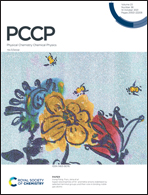Structural determination of arginine-linked cisplatin complexes via IRMPD action spectroscopy: arginine binds to platinum via NO− binding mode†
Abstract
Cisplatin, (NH3)2PtCl2, has been known as a successful metal-based anticancer drug for more than half a century. Its analogue, Argplatin, arginine-linked cisplatin, (Arg)PtCl2, is being investigated because it exhibits reactivity towards DNA and RNA that differs from that of cisplatin. In order to understand the basis for its altered reactivity, the deprotonated and sodium cationized forms of Argplatin, [(Arg-H)PtCl2]− and [(Arg)PtCl2 + Na]+, are examined by infrared multiple photon dissociation (IRMPD) action spectroscopy in the IR fingerprint and hydrogen-stretching regions. Complementary electronic structure calculations are performed using density functional theory approaches to characterize the stable structures of these complexes and to predict their infrared spectra. Comparison of the theoretical IR spectra predicted for various stable conformations of these Argplatin complexes to their measured IRMPD spectra enables determination of the binding mode(s) of Arg to the Pt metal center to be identified. Arginine is found to bind to Pt in a bidentate fashion to the backbone amino nitrogen and carboxylate oxygen atoms in both the [(Arg-H)PtCl2]− and [(Arg)PtCl2 + Na]+ complexes, the NO− binding mode. The neutral side chain of Arg also interacts with the Pt center to achieve additional stabilization in the [(Arg-H)PtCl2]− complex. In contrast, Na+ binds to both chlorido ligands in the [(Arg)PtCl2 + Na]+ complex and the protonated side chain of Arg is stabilized via hydrogen-bonding interactions with the carboxylate moiety. These findings are consistent with condensed-phase results, indicating that the NO− binding mode of arginine to Pt is preserved in the electrospray ionization process even under variable pH and ionic strength.



 Please wait while we load your content...
Please wait while we load your content...